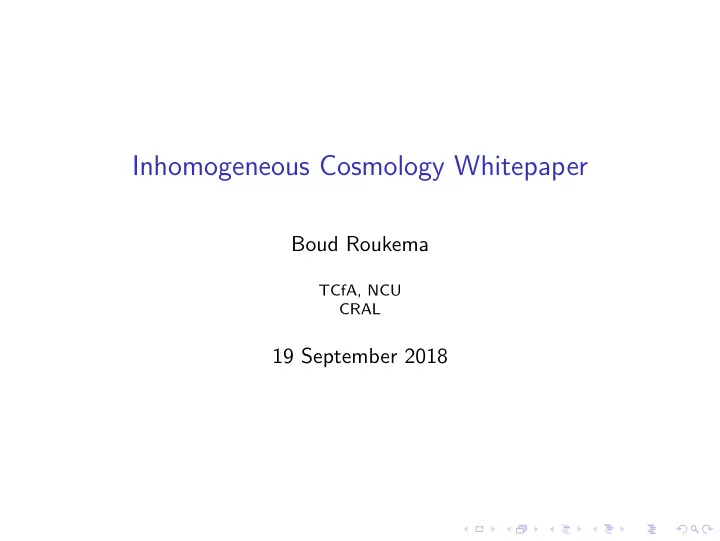

Inhomogeneous Cosmology Whitepaper Boud Roukema TCfA, NCU CRAL 19 September 2018
Chronology ◮ July 2017 @CosmoTorun17 = IC II: initial idea
Chronology ◮ July 2017 @CosmoTorun17 = IC II: initial idea ◮ June 2018 white paper started by Jan — web: https://overleaf.com/16937394rvbwybqsvgjp or git clone https://git.overleaf.com/16937394rvbwybqsvgjp
Chronology ◮ July 2017 @CosmoTorun17 = IC II: initial idea ◮ June 2018 white paper started by Jan — web: https://overleaf.com/16937394rvbwybqsvgjp or git clone https://git.overleaf.com/16937394rvbwybqsvgjp ◮ June, July, Sep 2018 — edits Jan, Boud, Krzysztof B
Chronology ◮ July 2017 @CosmoTorun17 = IC II: initial idea ◮ June 2018 white paper started by Jan — web: https://overleaf.com/16937394rvbwybqsvgjp or git clone https://git.overleaf.com/16937394rvbwybqsvgjp ◮ June, July, Sep 2018 — edits Jan, Boud, Krzysztof B ◮ 17 Sep — discussion by IC III participants (added 18 Sep)
Editing ◮ identify yourself! many obvious options
Editing ◮ identify yourself! many obvious options ◮ https://overleaf.com/16937394rvbwybqsvgjp or
Editing ◮ identify yourself! many obvious options ◮ https://overleaf.com/16937394rvbwybqsvgjp or ◮ git clone https://git.overleaf.com/16937394rvbwybqsvgjp
Authorship proposals ◮ anonymous contributions will be removed, unless attributed (by email or other reliable communication)
Authorship proposals ◮ anonymous contributions will be removed, unless attributed (by email or other reliable communication) ◮ 17 Sep contributors:
Authorship proposals ◮ anonymous contributions will be removed, unless attributed (by email or other reliable communication) ◮ 17 Sep contributors: ◮ default: “author” names shifted to “Thanks for comment” in Acknowledgments unless the contributor edits the paper either via the web or git
Authorship proposals ◮ anonymous contributions will be removed, unless attributed (by email or other reliable communication) ◮ 17 Sep contributors: ◮ default: “author” names shifted to “Thanks for comment” in Acknowledgments unless the contributor edits the paper either via the web or git ◮ author list: major authors (order TBD); minor authors (alphabetical);
Authorship proposals ◮ anonymous contributions will be removed, unless attributed (by email or other reliable communication) ◮ 17 Sep contributors: ◮ default: “author” names shifted to “Thanks for comment” in Acknowledgments unless the contributor edits the paper either via the web or git ◮ author list: major authors (order TBD); minor authors (alphabetical); ◮ decision-making method: rough consensus, by email and/or irc
Question 1 Are these two interpretations — weak field on a flat background versus a fully non-linear GR approach of differential expansion — physically equivalent in the sense of being observationally indistinguishable, provided that the conditions for the weak field limit to be valid are matched by the actual space-time?
Question 2 What are the quantitative conditions required for these two interpretations to be indistinguishable?
Question 3 Does the weak-field approximation allow for non-zero rotation? Or is w ab = 0 an implicit assumption of this scheme?
Question 4 What is the physical meaning of the scalar spatial curvature?
Question 5 What is the physical meaning of the Poisson gauge? Does it make sense to talk about a set of observers in this gauge?
Question 6 What is an element of fluid in the real universe? What kind of limitations do we meet while using the fluid approach in cosmology?
Question 7 Can the small scales (few comoving Mpc) be handled accurately by existing numerical approaches that do not take into account virialisation?
Question 8 Why is backreaction and spatial curvature small in gevolution results? What is the role of assumptions on the topology of the spatial section?
Question 9 Are gevolution simulations mathematically self-consistent — which terms are set to zero? Could the ignored terms accumulate to significantly high values over a Hubble time?
Question 10 Is the difference between results by Adamek, Macpherson etc and Bruni, Bentivegna etc only due to the gauge choices? Do they agree at the level of observables?
Question 11 What are the observables from the Buchert approach, exact solutions, gevolution, ET, simsilun, VQZA that can be tested by model independent methods (CBL test, most massive objects in the universe)?
Conclusion: few months from now? ◮ please edit! ◮ cf Wikipedia talk pages: coordinate with the other editors by email and/or irc to solve conflicts
Recommend
More recommend